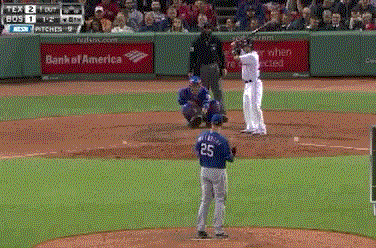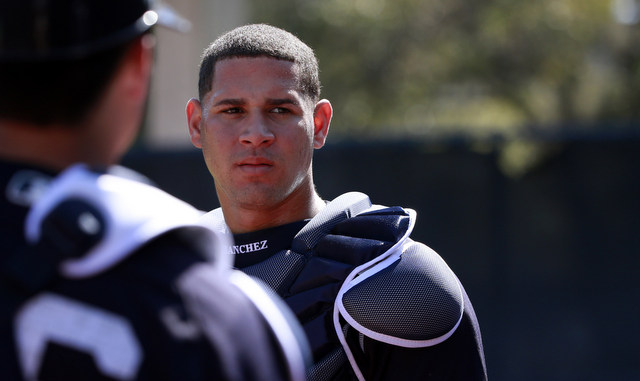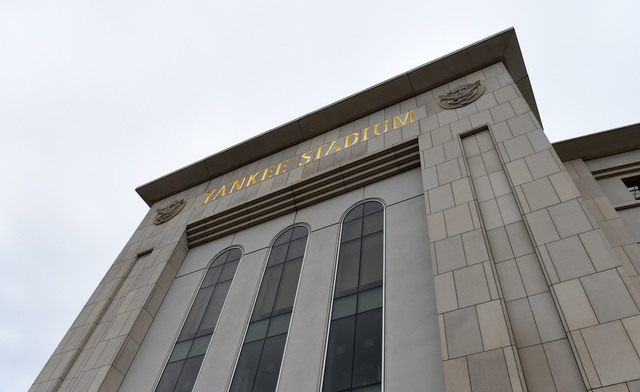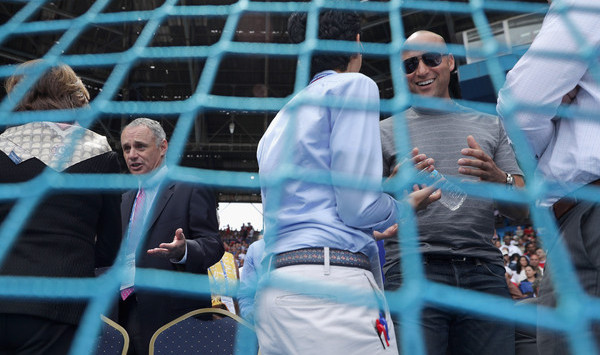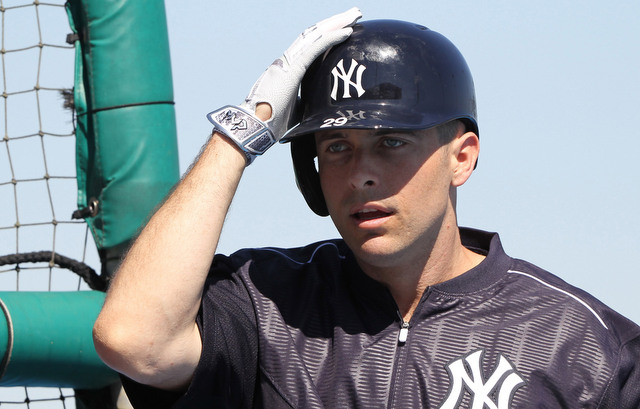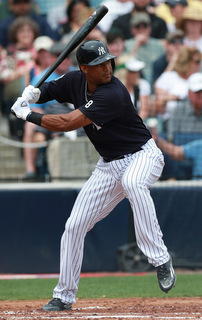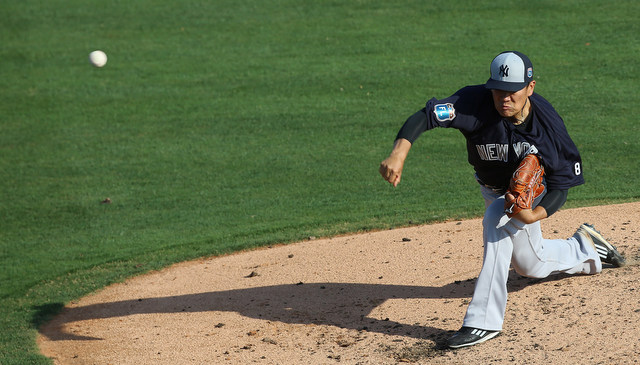Got ten questions in the mailbag this week, and some of the answers are longer than usual. As always, make sure you use the RABmailbag (at) gmail (dot) com email address to send us questions.
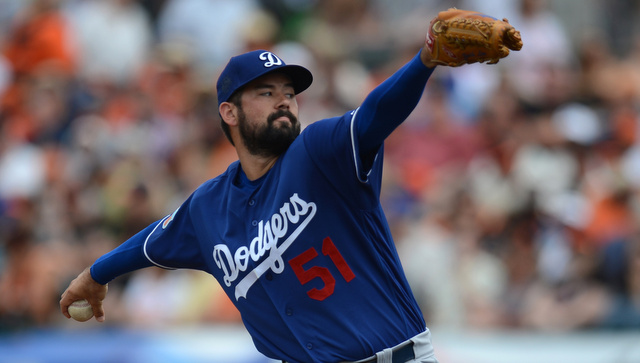
Matt asks (short version): Who might the Yankees target for their next “guy with lots of talent, but hasn’t put it together yet” trade? I happen to be a big fan of Mike Foltynewicz, whom I don’t even see on the Braves Depth Chart at the moment.
Foltynewicz is a good one and he definitely fits the Yankees’ mold as a hard-thrower (averaged 95.1 mph in 2015) with a history of missing bats. His walk rates are probably a bit too high though. The Yankees tend to seek out low walk guys like Nathan Eovaldi and Michael Pineda. Foltynewicz had surgery in September to remove blood clots from his arm and the Braves are bringing him back slowly this spring.
The Yankees have been targeting these “out of favor” players over the last two offseasons and it’s worked out pretty well so far. Eovaldi and Didi Gregorius worked out great. This year we’ll see how Aaron Hicks and Starlin Castro work out. As always, it’s tough to predict who will be available next offseason, but here are some possible targets for similar trades:
- 1B/OF Wil Myers, Padres: He had an impressive debut in 2013 (129 wRC+) but he’s struggled to stay healthy since, with ongoing wrist problems the main culprit. He did have a 116 wRC+ in 60 games last year. The Padres are playing Myers at first base, though you could always stick him back in the outfield. Either way, he’s a bat first player.
- C Mike Zunino, Mariners: Zunino has maybe the worst plate discipline in baseball (.252 OBP in over 1,000 plate appearances!) but he has huge power (video) and is a premium defender. He was drafted by the previous regime and new GM Jerry Dipoto acquired two catchers this winter (Chris Iannetta, Steve Clevenger), so Zunino’s buried on the depth chart.
- RHP Alex Meyer, Twins: The Yankees love big hard-throwers and Meyer is listed at 6-foot-9 and 220 lbs., and PitchFX clocked his average fastball at 95.6 mph in his MLB debut last year. His control stinks though, and it’s looking more and more likely he’ll be a reliever long-term. The Twins already sent him to Triple-A this spring, so he’s still has not nailed down an MLB job at age 26. Meyer has some similarities to Dellin Betances, though he doesn’t have Dellin’s breaking ball.
- RHP Zach Lee, Dodgers: Lee’s stuff did not take the step forward many expected after he stopped playing football a few years ago. He throws a lot of strikes with a mostly 89-92 mph fastball, and he has a few different offspeed pitches. Lee’s a fantastic athlete — he was a four-star quarterback recruit out of high school — and I’m a fan of betting on athletes. The Dodgers have buried him way down on the depth chart too. If he’s in their plans, they have a funny way of showing it.
These guys have name value as former top prospects. They’ve all struggled to find success for whatever reason(s) and they all have some kind of carrying tool. Myers has offensive potential, Zunino has power and defense, Meyer has a big fastball, and Lee has a deep arsenal and control. This is a question worth revisiting in the future as things change around the league.
(Jarred Cosart and Tony Cingrani also crossed my mind as possible trade targets. )
Asher asks: If Refsnyder continues to learn a passable third base, would trading Headley become an option?
Sure, though I think we’re a long way from the Yankees even considering that. Remember, the Yankees would not play Rob Refsnyder over Stephen Drew last season, even though a) Drew was awful for long stretched, b) Drew was a veteran signed a one-year deal, and C) it was a position Refsnyder was familiar with. Is it possible Refsnyder shows the Yankees enough defensive competence and offensive production to convince them he can be a regular at this base? Of course. I just can’t possibly imagine how that would happen this year, especially as a part-time player. Based on everything that’s happened the last year or so, it seems pretty clear fans have a much higher opinion of Refsnyder than the Yankees.
Travis asks: If CC Sabathia were to be released at any point before next season (highly unlikely as it may be) what would happen with his vesting option? Would he just get the $25M he would be owed, then could sign for the league minimum with another team?
I believe he would get the $25M in 2017 for a few reasons. One, if it was that easy to get out of a vesting option, teams would be releasing players much more often. (And the MLBPA would freak.) Two, none of the conditions that would void the option would have been met. Sabathia wouldn’t spend time on the DL with a shoulder problem and he wouldn’t pitch in relief for the Yankees. If any of that happened, the option wouldn’t vest in the first place. Once he’s released, another team could sign Sabathia for the pro-rated portion league minimum, just like any other released player.
Will asks (short version): With all the talk of money coming off the books in the next two years, the implication is that this will trigger a spending spree as has happened in past years when money became available. Do you expect to see such a spree or do you think the team will stick with their recent development philosophy, essentially reserving their money to retain their developed talent long term?
I’m not convinced the Yankees are planning a big spending spree once all the money comes off the books. The team wants to get under the luxury tax threshold, that much is clear, and I don’t think they’ll spend big again until they accomplish that goal. Also, teams have to stay under the threshold two consecutive years to max out the revenue sharing rebates, so getting under might not be a one year thing. (The rebates could always change with the upcoming Collective Bargaining Agreement.)
There’s also this to consider: the upcoming free agent classes are pretty weak. The free agent class we just saw was the best one in years and will be the best one we see until the 2018-19 offseason, the Bryce Harper/Manny Machado/Jose Fernandez offseason. The Yankees could intend to spend again in a year or two, but there simply might be any free agents worth a significant investment. I think the plan is to build a new core from within and supplement through free agency. That’s how the late-1990s dynasty was built and that’s what successful teams like the Giants and Cardinals have done lately.
Daniel asks (short version): After sitting out this offseason on not just big but all free agents, are the Yankees setting up to make the big push to sign Stephen Strasburg? I feel like the only competition they would have would be the Nats and it doesn’t appear they are going to make much of an attempt with Scherzer signed long term and Giolito ready to go.

Strasburg is by the best pitcher scheduled to become a free agent next offseason — he’s better than anyone scheduled to hit the market in the following offseason too — and Scott Boras is surely looking to top the Max Scherzer and David Price contracts. Strasburg doesn’t have a Cy Young like those guys, but he is younger, he has fewer miles on his arm, and Boras will happily claim the late-season shutdown a few years ago means he’s a great bet to stay healthy long-term.
This is the kind of contract the Yankees seem to be avoiding right now. Those huge money long-term contracts that now include opt-out clauses, which potentially rob the team of some value. I think a ton of teams will be on Strasburg next year — the Cardinals, Red Sox, Tigers, Dodgers, Angels, Rangers, Astros, Cubs, and Giants could all get involved — and even if not, Boras will figure something out. The Yankees should absolutely inquire. It doesn’t cost anything to make the phone call. It just seems like they’re a few years away from another big signing like this.
Chip asks (short version): The Yankees have used ten second basemen the last two years. What were their combined offensive numbers and how did that compare to Cano over the last two years? If you figure that the early years were the most productive of Cano’s contract and the Yankees got reasonably similar production, then maybe letting him walk while they tried to find a full time replacement was the right move after all.
The Yankees have managed to use ten different starting second basemen and eleven different second basemen overall the last two years. Here’s the list, from most innings at second to least:
- Stephen Drew — 1,166.1
- Brendan Ryan — 259.2
- Brian Roberts — 774.2
- Jose Pirela — 186.2
- Martin Prado — 140.1
- Rob Refsnyder — 106
- Yangervis Solarte — 105
- Gregorio Petit — 93
- Dustin Ackley — 63
- Dean Anna — 17
- Kelly Johnson — 2
All except Anna (two starts) and Johnson (no starts) started at least nine games at second base. Combined, those guys hit .235/.292/.396 (77 wRC+) in just over 1,200 plate appearances from 2014-15. Throw in the defense and the Yankees have gotten -1.1 fWAR from their second basemen the last two years. Only the White Sox (-1.4 fWAR) have gotten worse production at the position. Robinson Cano, meanwhile, has hit .300/.358/.450 (126 wRC+) with +7.3 fWAR with the Mariners.
The Yankees didn’t get anything close to Cano numbers from their second basemen the last few years and that was completely expected. Robbie was — and still is, I think — the best second baseman in baseball, and that by definition makes him irreplaceable. The Yankees were always going to take a huge hit at second after Cano left. They were willing to trade the short-term hit for avoiding the ugly decline years at the end of the contract. I was totally cool with letting him walk on that contract. Seattle made it very easy to say goodbye.
Jackson asks: In the last couple of drafts, pitchers that Yankees took have seen a bump in velocity. Kap went from 92 to 95/97, Adams from about 93 to about 96 and Carter from low 90s to 96/97. Is this normal for a few percent of pitchers of draft age, or do the Yankees see something in the player before the draft, or is it just luck?
James Kaprielian’s velocity started to jump late in the spring last year when he was still in college. There were reports he was more 92-94 mph in May, a few weeks before the draft, after sitting 89-92 mph most of his time at UCLA. Kaprielian then went from 92-94 mph to 94-95 mph in pro ball, and he’s apparently sustained that this spring.
When something like this happens once or twice, it’s probably just one of those things. It’s happening repeatedly though. Kaprielian added velocity, as did Chance Adams and Will Carter from the 2015 draft. Jordan Montgomery and Jonathan Holder were 2014 draftees who added 2-3 mph. Tyler Webb and Cale Coshow added velocity following the 2013 draft. Something’s going on there.
It’s not uncommon for high school players to add velocity because they start out as babies. They come to pro ball all gangly and full of projection, then they fill out and mature. Most college players have already gone through that by time they’re drafted. They tend to come to pro ball as more of a finished product physically. In fact, it’s not uncommon for college starters to lose velocity in pro ball because they go from starting once a week to once every five days.
I can’t explain why the Yankees have seen some of their recent draftees add velocity in pro ball, and for all we know it could just be one giant coincidence. It’s happened so often that I have to think there’s something to this though. The Yankees brought Gil Patterson back following the 2012 season and he has a great reputation for developing arms. Maybe it’s all Patterson? He left to rejoin the A’s in November, so I guess we’ll see what happens with the 2016 draftees.
Rubaiyat asks: Since he missed so much time due to a variety of circumstances, do you think Ty Hensley will be moved to the pen full time? Or is it better to keep him stretched out?
At this point the best place for him is wherever keeps him healthy. Hensley’s thrown 42.1 innings total in three and a half years of pro ball. Steven Matz has shown it’s possible to come back from missing so much time early in your career — Matz was drafted in 2009 and he didn’t actually pitch in his first pro game until June 2012 because of Tommy John surgery and subsequent setbacks — but he’s the exception, not the rule. Not many players make it back from that kind of layoff.
Hensley came into pro ball as a fastball/curveball pitcher who needed to work on his changeup and command, and he hasn’t been able to work on that stuff because he’s missed so much time. I say keep him in the rotation for the time being for sure. He needs to get innings. But long-term, his future may now lie in the bullpen because he’s lost so much development time. The good news is his rehab is going well according to farm system head Gary Denbo, so we should see Hensley on the mound at some point in 2016.
Rob asks: Few bullpen arms have stood out yet. Ross Ohlendorf tripped his opt-out the other day. Is he worth a flyer?
True story: I own a Yankees’ Ross Ohlendorf player shirt. I bought it back in either 2007 or 2008, when I thought he was going to be a bullpen mainstay. It’s a wash or two away from disintegration at this point. I wear it to bed once in a while. A few years back Ohlendorf reworked his mechanics to add deception, and he now has a real old timey delivery that is just a treasure:
That’s outstanding. Anyway, I looked at Ohlendorf when he opted out earlier this week, and I’m not sure there’s much there to get excited about. He’s been very homer prone throughout his career (1.86 HR/9 in 2015 and 1.31 HR/9 career) and neither his strikeout nor walk rates have been anything special, even in relief.
There’s no such thing as a bad minor league contract, so bring Ohlendorf in that case. I’m not sure it’s worth pushing one of the shuttle relievers to Triple-A to give him a big league bullpen spot though. Ohlendorf’s not enough of a clear upgrade.
Michael asks: What was your favorite Alex Rodriguez regular season moment?
You know, as great as A-Rod has been, it was tough for me to come up with an answer here. I was at his 500th home run game, so that stands out to me. I’ll never forget that. I also saw A-Rod hit a walk-off grand slam against the Orioles and Chris Ray early in that 2007 season, so that stands out too:
Other regular season moments that stand out: the three homer, 10 RBI game against Bartolo Colon and the Angels, the home run on the first pitch he saw following hip surgery in 2009, his 3,000th hit, and the home run off Ryan Dempster after Dempster threw at him in 2013. Missing anything obvious? As far all-time A-Rod moments, it’ll be hard to top the 2009 postseason. He was a monster from start to finish that October.
